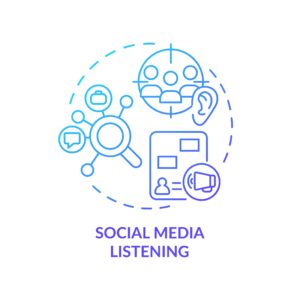
In the age of social media, it’s not enough for a brand to simply broadcast its message and hope it finds its target market. To truly connect with audiences, B2B brands need to listen to their customers and thoroughly understand what they are saying. This is especially true across digital channels such as online publications, social media and third-party review sites, where interaction and engagement are the name of the game. That’s why social listening is an essential practice for any business, especially B2B brands looking to get a pulse on their target market and stay a step ahead of the competition.
What Is Social Listening?
Empathetic listening is a valuable practice of any professional. “Developing trust with your client comes down to listening,” says John Stoj, founder of Verbatim Financial on the SalesPop! Podcast. “It’s about building a relationship, and that can’t happen if you only talk and don’t listen.”
Social listening takes the concept of listening to your customers a step further and amplifies it to your brand’s marketing and sales tactics. Social listening refers to the practice of monitoring and analyzing online conversations and discussions happening across various channels. While social monitoring focuses on a company, brand or marketing campaign, social listening tracks brand mentions in addition to entire sectors, industries and trends. By tracking brand mentions, industry keywords, customer feedback and competitor activities, marketers can gain valuable insights about what audiences are saying about them, their competitors and the marketplace. The word “social” doesn’t mean this method only applies to social media channels. It includes monitoring mentions anywhere on the web, including blogs, forums, news sites and other online publications.
Three Realities of Social Listening for Today’s B2B Businesses
To harness the power of the authentic and real-time insights offered through social listening, it’s important to understand the current state and best practices of today’s digital conversation. Here are three realities to keep in mind when developing a social listening strategy:
1. Tools are essential.
There is a lot of noise when it comes to digital spaces. Globally, over 6 billion people use social media. So, it’s important to make a targeted effort to discover, track and act on the relevant conversations of your target prospects and customers. The process of social listening involves setting clear objectives and defining relevant keywords and topics. It also involves monitoring and analyzing the relevant conversations that surround those keywords. With the fast pace and high volume of digital conversations, digital tools are a must. Brands such as Hootsuite, Sprout Social, Brandwatch, Mention and BuzzSumo offer social listening programs that enable users to tackle the tasks of social listening in one centralized place. Some platforms such as Instagram, Facebook and LinkedIn have native social listening tools to conduct audience research in relation to your own brand’s posts and profile.
2. Social listening extends beyond monitoring brand mentions.
Tracking media mentions for your brand is important. However, it’s essential for today’s B2B businesses to listen to their target audience’s conversations as well. These dialogues may be related to industry trends, pain points, competitor activities and emerging topics. By monitoring a broader spectrum of discussions, brands can uncover insights that shape their content strategy, product development and customer engagement efforts. For example, Sprout Social provides useful social listening features like audience demographic analysis, customer sentiment tracking, influencer identification, campaign analysis and competitor comparisons. This variety of information helps brands keep an eye on the broader conversation at hand, not just direct engagement.
3. Be a part of the conversation.
Simply listening to what your prospects and customers are saying isn’t enough to manage your reputation or garner value from digital conversations. Successful social listening demands action. Empowered with customer insights, use the channels they use to be a part of the conversation. You can also respond to customer complaints and position your expertise where prospects and customers can find it. Also, create and distribute powerful content such as articles, blogs, interviews, podcasts and speaking engagements to showcase your expertise and insights.
Reputation management is both proactive and reactive. Digital marketing expert Melih Oztalay explains how prompting conversations about your brand empowers conversion rate optimization (CRO). “An essential aspect of CRO, social proof is based on the idea that people pay attention to brands that are liked and accepted by social influencers. That doesn’t mean you need a Kardashian to endorse your products, although it would undoubtedly be helpful,” Oztalay says. “What you can do, though, is showcase a testimonial from an industry expert or publish case studies from other clients discussing how your product solved their problem.” Surveys, polls, and direct customer feedback are other vital ways to prompt valuable conversation.
Keep an Ear to the Ground

In a fast-paced and interconnected world, conversations unfold across countless channels. Understanding the landscape in which your audience engages is crucial. As such, social monitoring is a must. It tells marketers what their audiences are talking about. But it isn’t enough. Social listening helps marketers uncover why audiences are talking about their brand, competitors and trends. Armed with these powerful insights, marketers can transform feedback into customer-centric messaging and solutions that strengthen relationships and create a strong corporate differential in an increasingly crowded marketplace.

